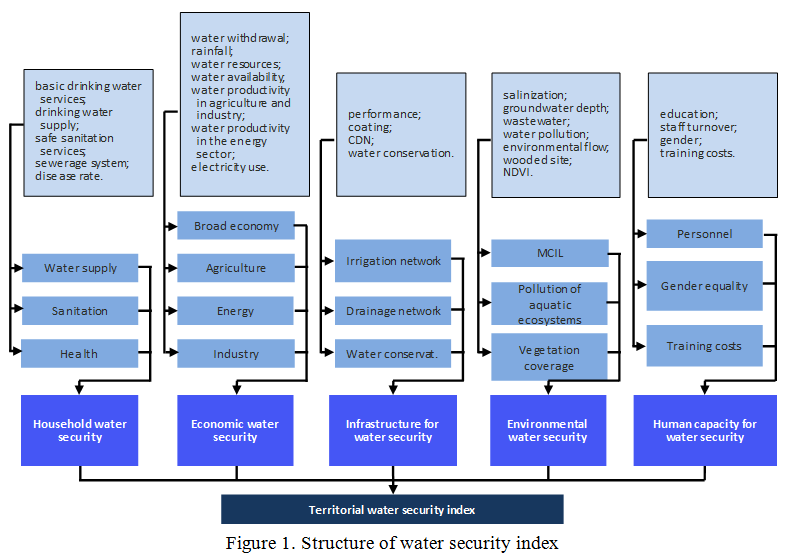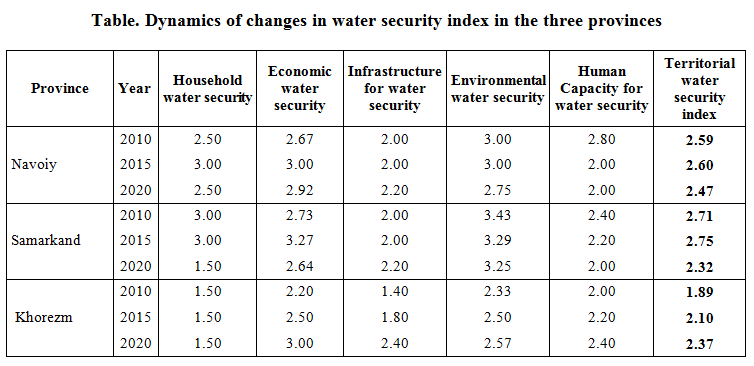Project “Uzbekistan Water Security Outlook 2020” on the example of Navoiy, Samarkand and Khorezm provinces
Client: UNESCO
Executor: Scientific-Information Center of ICWC
Duration of the project: November 11, 2021 – March 31, 2022 (Khorezm province), May 20- July 1, 2022 (Navoiy and Samarkand provinces)
Project objectives:
- 1. Preparing a database using statistics and information available at national and international level for assessing water security;
- 2. Drafting the 1st version of the “Uzbekistan Water Security Outlook”, identifying the list of necessary data/recommendations for more accurate/detailed assessment of water security;
- 3. Developing a template for Water Security Concept.
- 4. Preparing the Uzbekistan Water Security Outlook on example of Navoiy, Samarkand and Khorezm provinces.
Outputs for the reporting period:
1. A framework/methodology for the assessment of territorial water security in Uzbekistan has been developed on the basis of statistics and information available at relevant water management organizations.
2. The review of water security in Navoiy, Samarkand and Khorezm provinces have been made.
3. The research results on the project were presented before the Scientific-Technical Council of SIC ICWC on October 13, 2022.
Framework/methodology for water security assessment
The methodology has been developed by SIC ICWC experts based on the approach of the Asian Development Bank. This methodology adapts ADB water security indicators to territorial characteristics of water management and the targets set in the national strategies and concepts of the development of agriculture, forestry, water, and green economy and other fields in Uzbekistan . As a pilot study, the authors conducted assessment of water security in Navoiy, Samarkand and Khorezm provinces of Uzbekistan.
The assessment methodology is based on determination of the composite water security index consisting of the following five key dimensions:
- Household water security covers drinking water supply, sanitation and diseases related to household water quality.
- Economic water security covers water use in the real economy, water availability, etc.
- Infrastructure for water security covers quantitative and qualitative indicators of irrigation and drainage networks, as well as the degree of application of water-saving technologies.
- Environmental water security covers soil and water conditions of irrigated land, pollution of aquatic ecosystem, and vegetation coverage.
- Human capacity for water security covers qualitative indicators of personnel and training of staff at water management organizations.
Key indicators and sub-indicators are selected to describe each key dimension (Figure 1).

The key dimensions of water security are rated on an index scale from 1 to 5:
- Critical
- Inadequate
- Engaged
- Effective
- Model
When the water security index value equals 1, the situation in the water sector is hazardous and there is a significant gap between the current and potential level of water security.
With the index equaling 5, the territory has high water security and can be considered as a model for effective water management and application of water conservation.
Data sources
Household water security – Data from the State Statistical Committee for 2010, 2015, and 2020.
Economic water security – Data for 2010, 2015, and 2020 from the Ministry of Water Management, Center of Hydrometeorological Service (UzHydromet), State Statistical Committee, and available meteorological data from the Meteocenter.
Infrastructure for water security – Data for 2010, 2015, and 2020 from the Ministry of Water Management.
Environmental water security – Data for 2010, 2015, and 2020 from the Ministry of Water Management and the Global Environmental Flow Information System for 2022.
Human capacity for water security – Authors’ assessments on the base of data from BISA, ISA, RID, PSE&CA, and LRFO of respective provinces for 2010, 2015, and 2020.
Comparative overview of water security in Navoiy, Samarkand and Khorezm provinces
Analysis of the water security index in the three provinces shows that, in general, over the period of 2010-2020, the consolidated water security index in these provinces remained at “engaged” level. At the same time, there is a declining trend change in the index in Navoiy (0.12) and Samarkand provinces (0.39), and, on the contrary, the index improved in Khorezm province (0.49) from “inadequate” to “engaged” (Table).
The decline in the water security index in the three provinces was mainly due to the key dimension of human capacity for water security. In addition, household water security in Samarkand and Khorezm provinces, as well as environmental water security in Samarkand and Navoiy provinces also contributed to this decline.

Recommendations
To improve water security in the three provinces, it is recommended to pay attention to the following:
- increase quantity of hydrological and meteorological observation points to improve water monitoring and accounting; ensure accessibility and transparency of the data on all water security dimensions; it is important to have spatially disaggregated data on all indicators and sub-indicators for more reliable assessment of the security level of key dimensions and tracing of their dynamics;
- against the background of continuous population growth, construction of new residential areas, expansion of cities and settlements, it is necessary to take effective measures to radically improve the water supply system. This implies modernization and advanced development of diversion structures, off-takes, pumping stations, distribution units and water supply networks based on intensive introduction of modern energy and resource-saving technologies;
- improve quality and reliability of services providing access to safe drinking water and sanitation, especially in rural and remote areas; reduce water pollution;
- increase efficiency and productivity of land and water use to meet the growing water demand of the population and the economy by improving water management and water use in all economic sectors (i.e., improving the key dimension of economic water security to effective or model level);
- improve flow regulation along the Zarafshan River (Samarkand and Navoiy provinces) and operation of Amu-Bukhara Main Canal for better water supply to Bukhara province and Kyzyltepa district of Navoiy province;
- improve performance of inter- and on-farm canals, irrigation and collector-drainage systems (reconstruction, rehabilitation, coating, transfer to the private sector) and increase the pace of application of water conservation technologies;
- improve water diversion and transportation and irrigation technique and technologies by applying science evidence-based irrigation regimes and advanced technologies;
- revisit current irrigation regimes and water duty zoning, taking into account the changed crop production conditions (crop diversification, sowing of new crop types and varieties for which no irrigation depths were set in irrigation regimes), water and soil conditions (groundwater bedding), and applied water-saving technologies;
- re-use collector-drainage water in the zone of their generation thereby improving available water supply of irrigated land and reducing polluting discharges into rivers;
- introduce modern systems of monitoring over soil and water conditions of land, particularly consider the criteria for assessing the critical level of groundwater bedding (up to 2 m) taking into account low land salinization and groundwater salinity;
- regulate extraction of sand and gravel from the Zarafshan River while keeping a 300–500-m water protection zone for environmental preservation of the watercourse and prevention of groundwater drop in Samarkand province;
- arrange bank strips along watercourses, including canals, irrigation and collector-drainage networks and adjacent to other hydraulic structures to facilitate their operation, reconstruction, repair and rehabilitation and for sound water use, water accounting and other measures;
- speed up modernization, reconstruction and replacement of irrigation pumping stations and aggregates, as well as introduction of up-to-date energy-saving technologies to reduce electricity consumption for water pumping and achieve the target reduction of annual electricity consumption by pumping stations by 25% until 2030;
- continuously and regularly invest in institutional and technical capacity of the water sector; education and training of staff should be one of the main priorities of water leadership and local authorities;
- develop and operationalize public private partnerships (PPP) in water and agricultural sectors to achieve real return and create incentives for the private sector to finance water;
- develop and operationalize PPP models for recultivation of abandoned irrigated agricultural land, with the development of irrigation networks and hydraulic structures and involvement of large industrial enterprises as private partners;
- strengthen measures for better environmental resilience in the context of climate change and increased desertification;
- raise gender awareness in the water sector and involvement of women in water management;
- promote water cooperation between Uzbekistan and Tajikistan, given the transboundary nature of the Zarafshan River, the main water artery that feeds Samarkand and Navoiy provinces.